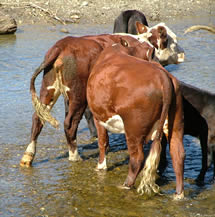“Non-point-source” or NPS pollution is pollution that cannot be traced to a single-source outfall such as a factory pipe discharging into the river. Examples of non-point-source pollution include stormwater runoff from lawns, roads, parking lots, building sites, and agricultural fields. This runoff can contain petroleum products, salt, animal waste, fertilizers, pesticides, heavy loads of sand and silt, or other contaminants. Failing septic systems or other contamination of groundwater can also contribute to NPS pollution.
Since the Clean Water Act went into effect, most point-sources of pollution have been identified and regulated. Their contribution to river pollution has decreased dramatically. NPS pollution is a much harder problem to solve, because the solution depends on individuals deciding to change the way they do things.
- Spare your local storm drain!
What goes into a storm drain may straight into a river, or may enter a river via a sewage treatment plant. EITHER WAY, most pollutants are not removed! To reduce the strain on storm drains…
- Avoid dumping soaps, oils, solvents, etc. in the driveway.
- Reduce or skip the use of herbicides, pesticides, or fertilizers on the lawn, especially before rain.
- Scoop your dog’s waste from the street or hard surfaces.
Let gutter outflow soak into the ground, or collect it in rain barrels.
- Keep the septic tank in good working order
- Fence pastures so that livestock don’t wade in the river.
- Allow a buffer zone of vegetation to grow up between an open field and the river’s edge.
This discourages geese from loitering, too.
For more information on non-point-source pollution, contact us.

